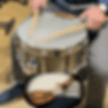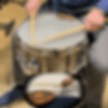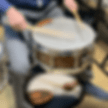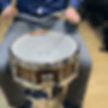Improve Your Snare Drum Practice!
- Nathan Coles
- Apr 21, 2023
- 4 min read
Updated: Oct 21, 2025
Focused and intentional daily practice can make a world of difference when it comes to honing your snare drum skills.
Meet Your Instructor: Gerardo Capaldo
Gerardo Capaldo is a Black Swamp Percussion Artist Endorser, author, composer, educator, and is a member of the Filarmonica della Scala. Gerardo's latest book, The Orchestral Tambourine, is an extensive dive into tambourine theory, practice, and etudes.
Daily Snare Drum Practice Routine
It's essential to dive deeper into the benefits of practicing consistently and developing a heightened awareness of the muscles and articulations involved in drumming. By dedicating time to practice on a regular basis, you can improve your drumming skills and overall performance.
When you begin your daily practice routine, it's crucial to take a mindful approach and focus on each muscle involved in the grip of the drumstick. Start by experimenting with various grips and stick positions to find the most comfortable and effective technique for you. This can help you to develop muscle memory and reduce the risk of injury.
Below are several grips demonstrated by Gerardo to practice single stroke exercises.
Fulcrum Isolation: Removing the thumb from the grip on the stick and hold the stick at it's fulcrum, or balance point, with your index finger. Your middle and ring finger will help balance and provide motion to the stick.

Open Fulcrum Control: This grip uses the thumb and index finger pinching the drum stick at the fulcrum. The middle finger will provide rebound point to the stick as it is in motion but will not hold the stick.

Closed Fulcrum Control: This grip is similar to the Open Fulcrum Control grip but will bring the remaining fingers to stick to provide a full resting place beneath the drum stick.

The Closed Fulcrum Control grip can also be used to address Wrist Control. Try alternating single strokes between hands and focus on only using your wrist to perform the stroke.

Try this same grip for a Controlled Doubles Exercise. This uses the Fulcrum plus your wrists and forearms.

Fingers Control Exercise: Using the Open Fulcrum Control grip, shift the fulcrum point between your index and middle fingers. This will build an equal balance between the two when adjusting for specific dynamic and tonal qualities.

Slowing things down a bit, working on a Weight Control Exercise will help develop an intentional sense to how your body moves and reacts with full arm and wrist motion. Try this exercise with all previous grips to gauge how your muscles feel and settle for each stroke.

Keeping on the topic of using a full range of motion, trying an Open Hand Grip (Open Fulcrum Control) paired with full wrist and forearm strokes will challenge your consistency of tone and articulation.

As you work on your grip, it's also important to practice musically, meaning that you should use appropriate articulations for each dynamic range. Be mindful of the physical limits of the instrument and aim to use the most natural and sonorous articulations possible. This can help to improve your technique and create a more expressive playing style.
Another helpful technique to incorporate into your daily practice routine is the use of a metronome. By playing along to a steady beat, you can improve your timing and accuracy. Start at a slower tempo and gradually increase the speed as you become more comfortable with the exercise.
Finally, remember to take breaks and listen to your body. Playing for extended periods without rest can lead to fatigue and injury. Take a few minutes to stretch, hydrate, and reset before diving back into your practice routine. By approaching your daily snare drum practice with a mindful and dedicated attitude, you can improve your skills, performance, and overall musicianship.
Applications for Practicing Repertoire
Mastering these grips and exercises requires a combination of technical proficiency and creative expression. As a percussionist, once you have developed a solid foundation of grip and motion control, you can begin to explore the full range of techniques available to you. With this knowledge, you can then apply these techniques to your repertoire and elevate your performance to new heights. The key is to approach each technique with an open mind and a willingness to experiment. By mixing and matching various techniques, you can develop a unique style that is both expressive and technically sound. This process takes time and dedication, but the payoff is well worth it. Gerardo explores how to apply these techniques to your repertoire for maximum impact in several orchestral snare drum excerpts.
Shostakovich - "Leningrad": Focus on fulcrum control
Ravel - "Bolero": Focus on closed fulcrum control with wrist and forearm motion
Korsakov - "Scheherazade 3rd Mov.": Focus on controlled doubles
Ravel - "Alborada Del Gracioso": Focus on wrist control and weight control
Korsakov - "Scheherazade 4th Mov.": Focus on fingers control and closed grip
Von Suppe' - "Pique Dame": Focus on fingers, closed grip, and forearms
Shostakovich - "10th Symphony, 1st Mov.": Focus on open grip and forearms
Shostakovich - "10th Symphony, 2nd Mov.": Focus on mixing grips and articulations
Additional Resources
As you continue to hone your drumming skills and explore the exercises outlined in this lesson, it's important to expand your musical horizons and seek out new sources of inspiration. One such source is our instructor, Gerardo, who has an extensive catalog of performances and compositions to explore. By immersing yourself in new works, you can gain valuable insights into different playing styles and techniques, and begin to develop your own unique approach to drumming. Take the time to study Gerardo's performances closely, paying attention to his use of dynamics, articulation, and phrasing. Try to incorporate some of these techniques into your own playing and see how they affect your overall sound and style. By drawing inspiration from a variety of sources and continuously pushing yourself to improve, you can become a well-rounded and versatile drummer, capable of expressing yourself in a variety of musical contexts.
